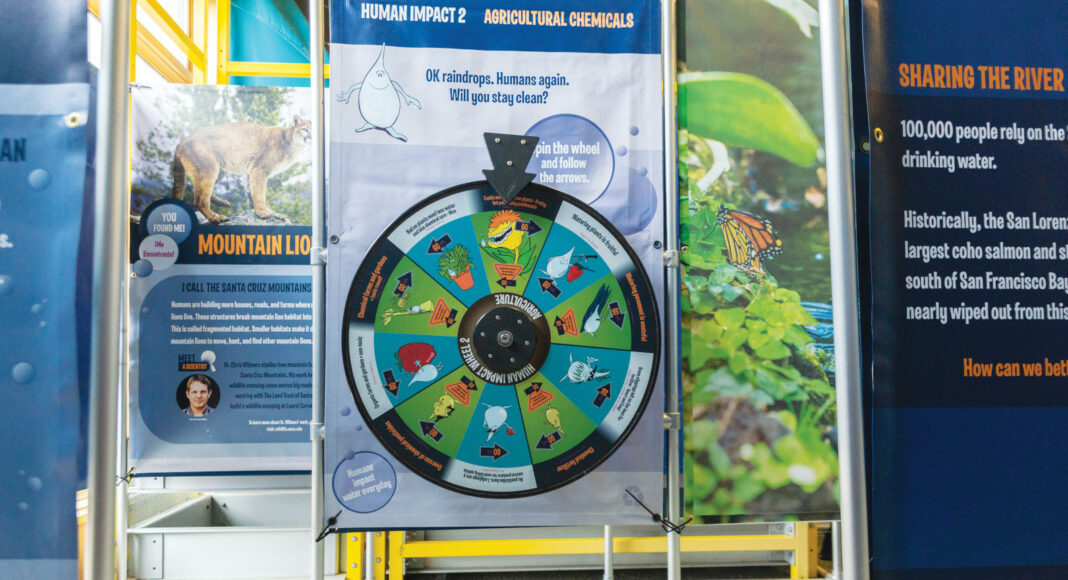The phrase “go with the flow” takes on new meaning at the latest Seymour Marine Discovery Center exhibit, “Water’s Extreme Journey.” In an interactive maze open until Dec. 31, visitors imagine themselves as water droplets trying to get to the ocean cleanly. They face pollution from litter, development and agriculture, among other manufactured obstacles. Maze-goers spin wheels and follow arrows to determine their fates.
Blurbs, photos, videos and activities line the maze walls. Some of the panels highlight water-related research happening at UCSC. Others spotlight iconic Santa Cruz species like mountain lions, banana slugs and sea otters. Moving through the space gives the sense that it’s all connected.
“Whatever we’re doing on land is going to run off into our oceans,” says Jonathan Hicken, the Seymour Center executive director. “You can’t really talk about the ocean without talking about the land and vice versa—especially in Santa Cruz County and other coastal communities. So thematically, it was an opportunity to make that connection for our community.”
As a water drop, visitors might run into common pollutants from roads, agriculture, development and even home gardens. Advice along the way suggests small daily changes that help keep water—and the rest of our environment—clean.
“It’s action-oriented,” says Hicken. “So, throughout the exhibit, there are places prompting the visitor to think about how they can conserve or protect water in their own lives.”
The maze offers tips that range from the often-heard “turn the sink off when brushing your teeth” to less common advice, such as washing cars on lawns rather than in the street.
Before designing the exhibit, the Seymour Center staff consulted with community leaders focused on water. Panels at the exhibit’s end show Santa Cruz’s unique watersheds and the problems facing our community.
“Nonprofits, scientists, city leaders and county leaders all were in a room, and we came up with these messages together,” says Hicken.
Three themes emerged from the conversations: water supply, water quality and climate change. The problems are interconnected. In Santa Cruz, climate change makes water supply challenges worse.
“We’re having more drought years, but when the rain does come, it comes in heavier storms,” says Hicken. “The land gets really dry, then the rain falls. And because it’s hard and clay-like, it just skips off the surface and runs down into the ocean. So these underground basins of water aren’t refilling at the same rate as they have historically.”
Near the coast, seawater begins to fill the underground space. Local water agencies are working to address the seawater intrusion and stormwater runoff challenges. These problems can seem large and overwhelming, but the Seymour Center believes the exhibit will help empower people.
“We hope that every visitor who comes in these doors walks out with something concrete and specific they can do in their own lives to get involved in this important environmental work,” he says. “Whether that’s volunteering or donating to one of these organizations, or for students, pursuing a career in the field—we hope everybody walks out a little bit more hopeful about our very local climate here.”
The exhibit comes to the Seymour Center during a period of redesign. After closing its doors for 18 months at the pandemic’s start, the center reopened last October. Guests can once again view and touch live animals like leopard sharks and move through exhibits. But Lauren Donnelly-Crocker, the center’s director of revenue operations, says a change is coming.
“We’re working on a new visitor experience plan that we’ll start sharing with the community pretty soon,” she says. “Action, art, community—these are our big things we’re trying to do right now.”
One area of focus, reflected in some panels of the water maze, is including Spanish and other languages in exhibits.
“We’re hoping to do that more as we move into the future to make sure that we are accessible to more audiences throughout Santa Cruz,” says Donnelly-Crocker. “Our goal is to bring the community together—nonprofits, researchers and community members.”
‘Water’s Extreme Journey’ runs through Dec. 31 at the Seymour Marine Discovery Center, 100 McAllister Way, Santa Cruz. Wednesday-Sunday, 10am-4pm. Free with admission. seymourcenter.ucsc.edu.














